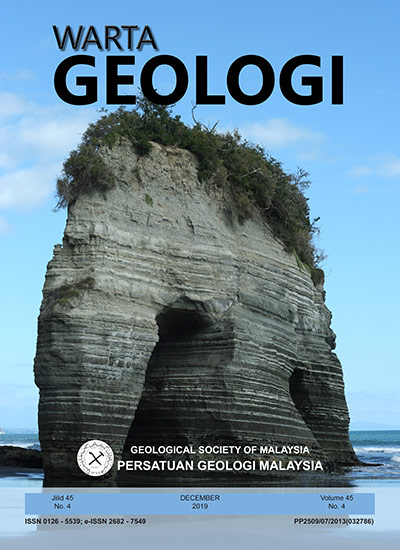
Warta Geologi, Vol. 45, No. 4, December 2019, pp. 400–404
High potential new Quaternary fossil cave sites in Merapoh (Pahang), with new geographic records for orangutan and Asian Black Bear
Ros Fatihah Muhammad1,*, Lim Tze Tshen2, Islahani Huda Sahak1, Nurameera Nadia Khairil Azhar1, Fakhrulradzi Mohd Razif1, Meor Hakif Amir Hassan1, Muhamad Laili b. Basir3, Muhammad Rosni b. Mamat3, Mohd Zainal Abidin b. Mohd Zin3, Sabrie b. Zoo3
1 Department of Geology, Faculty of Science, University of Malaya, 50603 Kuala Lumpur, Malaysia
2 Sarawak Museum Campus Project, Jalan Barrack, 93000 Kuching, Sarawak, Malaysia
3 Merapoh Adventure Clubhouse, Merapoh, Pahang, Malaysia
*Correspondence author email address: rosfmuhammad@um.edu.my
Abstract:
Cave sediments exceptionally rich with numerous vertebrate dental remains have been discovered in Merapoh, Pahang. To date, a total of 611 isolated teeth
have been collected, consisting of the following taxa: Hystricid, Rhizomys spp. (?), Helarctos malayanus, Ursus thibetanus , Neofelis nebuloso, Canid (?), Sus spp., Cervus unicolor, medium-sized Cervids, Tragulus spp., Capricornis sumatraensis, large-sized Bovids, Rhinocerotid, Cercopithecines and Colobines, Pongo sp. and possibly other higher primates. The faunal assemblage resembles those discovered in western Peninsular Malaysia that have been dated from 33-500ky (thousand years). Cave morphology shows the fissure filled with the sediments could have been part of a subterranean stream. The absence of bones may indicate that most of the fossils have gone through a long history of reworking and other taphonomic processes, and only the most resistant dental remains have been preserved.
Keywords:
Cave fossils, Quaternary vertebrate, cave sediments
Abstrak: Enapan
gua yang kaya dengan pelbagai tinggalan gigi haiwan vertebrata telah ditemui di Merapoh, Pahang. Sehingga kini, 611 gigi individu telah dikutip, terdiri dari
taxa berikut: Hystricid, Rhizomys spp. (?), Helarctos malayanus, Ursus thibetanus , Neofelis nebuloso, Canid (?), Sus spp., Cervus unicolor, Cervids bersaiz sederhana, Tragulus spp., Capricornis sumatraensis, Bovids bersaiz besar, Rhinocerotid, Cercopithecines dan Colobines, Pongo sp. dan kemungkinan primat yang lebih tinggi. Kumpulan fauna ini menyerupai kumpulan yang dijumpai di barat Semenanjung Malaysia yang telah ditentukan umur pada 33-500 ribu tahun. Morfologi gua menunjukkan fisur yang diisi dengan enapan mungkin adalah sebahagian dari aliran air bawah tanah. Ketiadaan tulang menunjukkan kebanyakkan fosil telah mengalami sejarah kerja semula dan proses tafonomi yang lain sehingga hanya tinggalan gigi yang paling tinggi ketahanan terpelihara.
ISSN
0126–5539; e-ISSN 2682-7549
DOI :
https://doi.org/10.7186/wg454201903